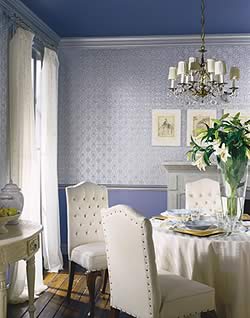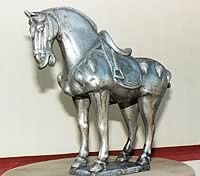
A Look at Metallic Paints
Although decorative painters are only recently turning to metallics in large numbers, creating pigments from metal flakes has been done since the Bronze Age
by Christina Camara
and giving them the choice of a flat or glossy finish are long gone. Homeowners, ever more sophisticated, are seeking painting contractors who have experience in decorative painting techniques. Savvy painters are expanding their skills, and many are mastering the use of metallic paints and powders to create a number of spectacular effects.
Metallics can make walls look like crumbling, old-world relics or shiny modern showpieces. They can change the new into the old; the ordinary into the extraordinary.
Although decorative painters are only recently turning to metallics in large numbers, creating pigments from metal flakes has been done since the Bronze Age, says Neil Cody of NCody Associates, who specializes in marketing and sales of faux and decorative products. “All we’ve done is perfect the grinding of it so we’re able to mill it down to very small particles.” And rather than mixing powders with glue made from animal hides, today’s metallic powders are suspended in glazes, lacquers, oil or acrylic varnishes, waxes and even liquefied glass.
Larry Neuberg, owner of Gold Leaf and Metallic Powders (GLMP), says metallics can be used in interiors and exteriors, and in commercial and residential applications. “They have their place almost anywhere,” he says. Any surface will accept a metallic finish — metal, primed drywall, textured surfaces, Venetian plaster and more.
GLMP offers 80 colors that include basic metallics, specialty micas and pearlescent, iridescent and sparkle products that are popular with faux finishers and decorative painters. One of the challenges in working with metallics is knowing which product to use to get the desired effect. “You need a true understanding of what you’re working with,” Neuberg says.
Metal powders are made from actual metal particles, such as copper, zinc and aluminum. Mica powders are made from mica and natural earth pigments that are chemically colored for light fastness.
Cody says one of the most common mistakes in using metallics is mixing metal powders with water-based clear coats, rather than oil-based products. Since metals are reactive, they will oxidize over time. Copper will turn green, bronze goes to greenish-black, and aluminum and zinc will turn black. “If it’s not intended, you definitely don’t want the surprise,” he says. Mica powders, on the other hand, are non-reactive and can be mixed with any medium with no worries about an unwanted patina.
Cody offered a few mixing tips: Never dump the powder into the varnish or glaze or other medium — the powder can fly into the air, it will clump, and the agitation will create air bubbles. Prepare the powder first by making a slurry with whatever thinner is appropriate for the clear coat it will be mixed with.
When using a water-based glaze as a medium for mica powders, first make a paste of the mica powder and denatured alcohol (not water), then mix the paste into the glaze. Use lacquer thinner with lacquer; mineral spirits with oil varnish; turpentine with waxes.
The flake size determines the type of finish — a coarse powder will produce a brilliant finish; fine powder will produce a dull finish, Cody says. He advises using a top-quality clear coat — the higher the quality, the more realistic the metal finish will look. Light will pass through it, and the high solids content will suspend the metal particles and create the illusion of depth. A smooth surface will allow more light reflection and give the best results, although metallics also work on textured surfaces to produce a distressed, antique look.
 |
 |
Creating a patina takes experience. Being something of an amateur alchemist helps too. Metal powders produce a patina when oxidized with corrosive acids, bleach or vinegar. For example, mixing a copper powder with vinegar will create a green tarnish; pale gold powder and vinegar will make a greenish-gray effect; brass with cupric nitrate and ammonium chloride will produce a bluish-green patina, Cody says. The longer the powder is exposed to the solution, the more intense the color will be.
Neuberg advises decorative painters to experiment, and to keep careful track of proportions and timing so good results can be repeated. Just as chefs tinker with recipes until perfection is achieved, the same can be said of using metallic powders. Manufacturers’ technical advisers can be contacted for guidance, especially if products from different manufacturers are being used on one project.
|

